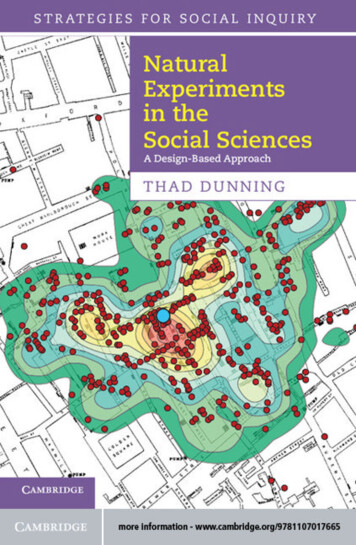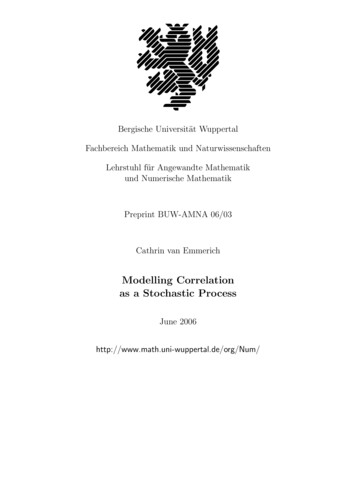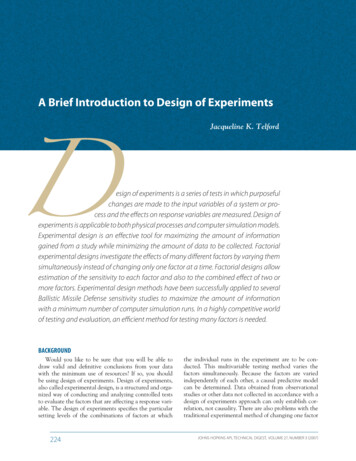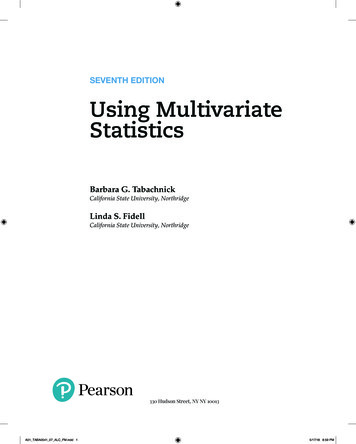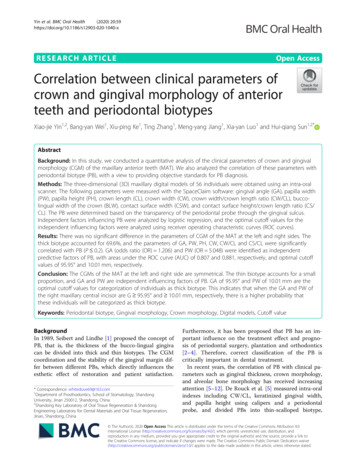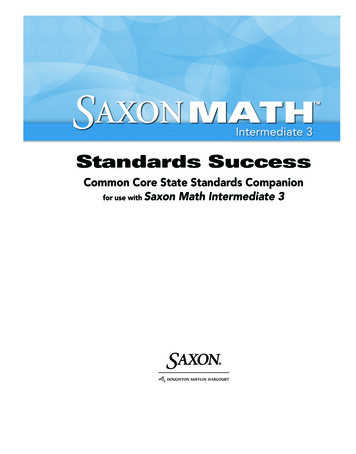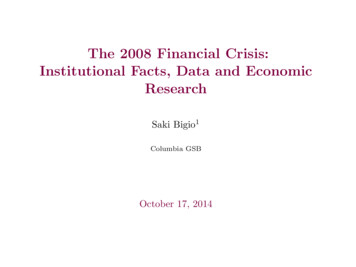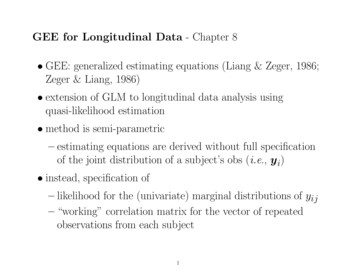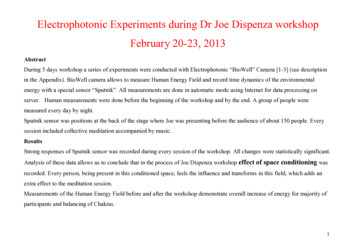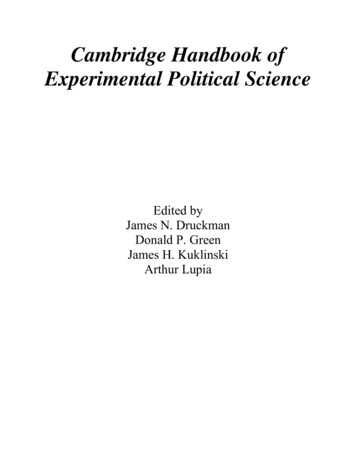
Transcription
2D Correlation Experiments:HSQC, HMQC, HMBC,BCMB/CHEM 8190
Two Dimensional NMR Spectroscopyδ (ppm)intensity- typically, the two axes are chemicalshifts (correlation spectroscopy), butnot limited to this (i.e. J-coupling, etc.)- convention is typically for directlyobserved dimension to be presentedalong the x-axis- correlations between x- and y-axisvariables based on:- J coupling (COSY, TOCSY, HSQC)- dipolar interactions (NOESY)- chemical exchange (EXSY)intensity Two-dimensional (2D) NMR spectra are presented along twoorthogonal axes (rather than one for 1D NMR)ν (f1)ν (f2)
Two Dimensional NMR Spectroscopy A general scheme for 2D experiments describes these asconstructed from 'preparation', 'evolution' and 'mixing' elements- preparation: create magnetization of interest- evolution 1: increment t1 time period, evolve magnetization with informationof interest (gives y-axis information, indirectly observed dimension)- mixing: mix magnetization to get observable magnetization of interest- evolution 2: acquisition period (magnetization evolves, direct observation) Example: COSY(correlation spectroscopy)- correlates chemical shiftsof coupled nuclei (usually 1H)- used as a stand-alone experiment for 1H-1H correlation, and as an elementin other pulse sequences for magnetization transfer/mixing- preparation is d1 and first 90 pulse: initial d1 period allows for recovery ofmagnetization (T1 recovery), pulse creates initial transverse magnetization- evolution: magnetization evolves with chemical shift and scalar coupling- mixing period (second 90 pulse) uses scalar couplings to transfermagnetization between coupled spins to create the magnetization of interest- evolution 2 (t2): magnetization evolves and is detected
Some Two-Dimensional NMR ection(t2)“mixing”9090COSY: CorrelationSpectroscopyt1COSY909090t1NOESYNOESY: NuclearOverhauser EffectSpectroscopyτm90t1TOCSY90x 180y 90y1Hτ13C18018090ττ180yHSQCTOCSY: TotalCorrelation Spectroscopy90x90t1/2t1/2τHSQC: HeteronuclearSingle Quantum Coherence180decouple
2D –NMR - FIDs are Transformed in t2, then in t1t1t1 0t1 DWt1 2DWt1 3DWFTt1 4DWintensityt1t1 5DWt1 NP DWν (f1)ν2ν (f2)
Three Dimensional NMR Spectroscopy In general, 3D experiments include the same elements as 2Dexperiments, just more of them- in a typical 3D experiment, there are three evolution periods, the first twocorresponding to the two indirectly-detected dimensions (t1 and t2), andthe third corresponding to the directly detected dimension (t3).- often, two 2D experiments are combined (cut/paste) to create a 3Dexperiment (NOESY-HSQC, NOESY-TOCSY, etc.) Modern biomolecular NMR utilizes many types of 3Dexperiments for resonance assignment, NOE-based distancemeasurement, etcetera
Heteronuclear Single Quantum Coherence The Heteronuclear Single Quantum Coherence (HSQC)experiment is one of the most used experiments in(biomolecular) NMR- the HSQC experiment is one of the fundamental building blocks of scoresof multidimensional, heteronuclear and triple resonance NMR experiments- the HSQC experiment correlates chemical shifts ofone nucleus to another (scalar coupled)- the 1H-15N pairs in amide groups of amino acids inproteins are convenient reporters for each amino acid- the 1H, 15N-HSQC spectrum of a protein is a"fingerprint", that can be used to monitor structuralchanges (ligand binding, solution conditions, etc.)- for highest sensitivity, uniform 15N labeling is used, butfor more concentrated samples, even naturalabundance samples can be analyzed with modern,high-sensitivity instrumentation and cryogenic probes- not at all limited to 1H-15N: 1H-13C important fororganic chemistry as well as biomolecular NMR
HSQC Spectrum of Amide H-N Pairs in a Protein HSQC spectrum of a protein (calmodulin) in the unbound stateand bound to a drug ("W-7")- the HSQC experiment is one of the fundamental building blocks of scoresof multidimensional, heteronuclear and triple resonance NMR experiments- chemical shift of amide 1H correlated to directly bonded 15N, for eachamino acid (notice chemical shift ranges)Ikura and coworkers, 1988calmodulincalmodulin withbound fonamide
HSQC Spectra of Other Nuclear Pairs HSQC (and HMQC, see later) are used to correlate many typesof nuclei- for biomolecular NMR, mostly 1H-15N, 1H-13C, 1H-31P, etc.- example below: 13C-103Rh
Preparation Period for HSQC Experiment The INEPT sequence serves as the 'preparation' period for theHSQC experiment (and many other experiments)- remember, 1H pulses do not excite 15N, and vice versa (so, two 'channels')- magnetization is transferred from 1H to 15N in order to improve thepolarization of 15N (sensitivity improved by γ1H/γ15N 10) and to allowchemical shift evolution (during t1) that depends on 15N chemical shift- initial z-magnetization is converted to –y (90 x), then to antiphase xmagnetization (following τ-180-τ, no chemical shift evolution)- 1H 90 y and 15N 90 x) convert to antiphase 15N magnetization!!abcdabIz -Iycd- for this pulse sequence, τ MUST beequal to 1/(4J)- for amide 1H-15N groups in proteins,J is large and very uniform ( 95 Hz),so, transfer is efficient (fast, τ 2.6ms), which minimizes T2magnetization losses -2IxSz -2IzSyI1z -I1y -2I1xI2z -2I1zI2y
Preparation Period for HSQC Experimentπ I1xΩ1Izt Ω2Izt2I1z I2 z I1y I2 z I1y cos(Ω1t) I1x sin(Ω1t) I2 z2 π J1,2I1zI2z t I1y cos(Ω1t)cos(π J1,2τ ) 2I1xI2 z cos(Ω1t)sin(π J1,2τ ) I1x sin(Ω1t)cos(π J1,2τ ) 2I1yI2 z sin(Ω1t)sin(π J1,2τ ) I2 zπ I1y I1y cos(Ω1t)cos(π J1,2τ ) 2I1xI2 z cos(Ω1t)sin(π J1,2τ ) I1x sin(Ω1t)cos(π J1,2τ ) 2I1yI2 z sin(Ω1t)sin(π J1,2τ ) I2 zπ I2y I1y cos(Ω1t)cos(π J1,2τ ) 2I1xI2 z cos(Ω1t)sin(π J1,2τ ) I1x sin(Ω1t)cos(π J1,2τ ) 2I1yI2 z sin(Ω1t)sin(π J1,2τ ) I2 z Detailed product operatorcalculation of thepreparation period (INEPT)- initial z magnetization on 1H (I1z, or Iz) isconverted to -y magnetization by the first90 1H pulseΩ1Izt Ω2Izt I1y cos2 (Ω1t)cos(π J1,2τ ) I1x sin(Ω1t)cos(Ω1t)cos(π J1,2τ ) 2I1xI2 z cos2 (Ω1t)sin(π J1,2τ ) 2I1yI2 z sin(Ω1t)cos(Ω1t)sin(π J1,2τ ) I1x cos(Ω1t)sin(Ω1t)cos(π J1,2τ ) I1y sin 2 (Ω1t)cos(π J1,2τ )- just before the final 90 pulses,the magnetization is antiphase xmagnetization on 1H (I1xI2z, or IxSz) 2I1yI2 z cos(Ω1t)sin(Ω1t)sin(π J1,2τ ) 2I1xI2 z sin 2 (Ω1t)sin(π J1,2τ ) I2 zsimplify I1y cos(π J1,2τ ) 2I1xI2 z sin(π J1,2τ ) I2 z2 π J1,2I1zI2z t I1y cos2 (π J1,2 t) 2I1xI2 z cos(π J1,2τ )sin(π J1,2 t) 2I1xI2 z cos(π J1,2 t)sin(π J1,2τ ) I1y sin 2 (π J1,2 t) I2 zsimplify I1y cos(2π J1,2 t) 2I1xI2 z sin(2π J1,2 t) I2 zt τ 1 / (4J ) 2I1xI2 z I2 zπI1y π I2x22 2I1zI2 y I2 y- the final pair of 90 pulses convert theantiphase x-magnetization on 1H (I1xI2z, orIxSz) to antiphase y-magnetization on 15N(I1zI2y or IzSy ), which enhances the 15Nmagnetization by γ1H/γ15N 10- The I2z term is removed by subtracting theresults obtained with the final 1H pulseapplied along y and -y( 2I1zI2 y I2 y ) ( 2I1zI2 y I2 y ) 4I1zI2 y or 2I1zI2 yor πI1y π I2x22 2I1zI2 y I2 y
Preparation Period for HSQC Experiment We described earlier the equilibrium density matrix (single spin)- there is no net chemical shift evolution during τ - 180 - τ period (chemicalshift evolution is refocused, as long as both spin 1 and spin 2 eachexperience a 180 pulse)πI1x2I1z I2 z I1y I2 z2 π J1,2I1zI2z t I1y cos(π J1,2 t) 2I1xI2 z sin(π J1,2 t) I2 zπ I1y π I2y I1y cos(π J1,2 t) 2I1xI2 z sin(π J1,2 t) I2 z2 π J1,2I1zI2z t I1y cos2 (π J1,2 t) 2I1xI2 z cos(π J1,2 t)sin(π J1,2 t) 2I1xI2 z cos(π J1,2 t)sin(π J1,2 t) I1y sin 2 (π J1,2 t) I2 zsimplify I1y cos(2π J1,2 t) 2I1xI2 z sin(2π J1,2 t) I2 zt τ 1 / (4J ) 2I1xI2 z I2 zπI1y π I2x22 2I1zI2 y I2 y( 2I1zI2 y I2 y ) ( 2I1zI2 y I2 y ) 4I1zI2 y or 2I1zI2 yor π 2 I1y π 2 I2x 2I1zI2 y I2 y
Evolution and Decoupling during t1 The t1 evolution period includes a 180 1H pulse in the center- using vector diagrams, the role of this pulse can readily be visualized- during the first t1/2 period the component vectors of the antiphase 15N magnetization(15N with 1H in the α state – SIα, and 15N with 1H in the β state – SIβ) rotate accordingto the Larmor frequency of the 15N nucleus and move apart from one anotheraccording to the scalar coupling, JIS- the 180 1H pulse exchanges the 1H α and β populations (vectors are exchanged),and the second t1/2 period refocuses the vectors (antiphase magnetization restored)- chemical shifts are NOT refocused, 15N-1H couplings ARE refocused (no netevolution of coupling- so, during t1, signal is modulated by 15N chemical shift, NOT JIS-2IzSy
Evolution and Decoupling during t1 During the t1 evolution period the 15N antiphase y-magnetizationevolves into y- and x-antiphase magnetization- the analysis here ignores scalar coupling, as we demonstrated that the 1H 180 pulse centered in the t1 evolution period refocused the couplings- below, chemical shift evolution and the 1H 180 pulse are consideredΩ2Iz t1 2 2I1zI2 y 2I1zI2 y cos(Ω2 t1 2) 2I1zI2 x sin(Ω2 t1 2)π I1x 2I1zI2 y cos(Ω2 t1 2) 2I1zI2 x sin(Ω2 t1 2)Ω2Iz t1 2 2I1zI2 y cos2 (Ω2 t1 2) 2I1zI2 x cos(Ω2 t1 2)sin(Ω2 t1 2) 2I1zI2 x cos(Ω2 t1 2)sin(Ω2 t1 2) 2I1zI2 y sin 2 (Ω2 t1 2)simplify 2I1zI2 y cos(Ω2 t1 ) 2I1zI2 x sin(Ω2 t1 ) The 15N y- and x-antiphase magnetization present following thet1 evolution period is modulated by the rotating frame chemicalshift of the 15N nucleus (Ω2)- this is how the 15N chemical shift ultimately modulates the final signal detected in t2,and how the 15N chemical shift is observed in the second dimension
15N 1H Magnetization Transfer and DetectionFollowing the t1 evolutionperiod, the antiphase 15Nmagnetization is converted toantiphase 1H magnetization(and a multiple quantum term)by the 15N and 1H 90 pulsesfgheThe τ -180 - τ period results in x-magnetization modulated by the 15N chemical shift(and the multiple quantum term, that is not observable)eπI1x π I2x222I1zI2 y cos(Ω2 t1 ) 2I1zI2 x sin(Ω2 t1 ) 2I1yI2 z cos(Ω2 t1 ) 2I1yI2 x sin(Ω2 t1 )f2 π J1,2I1zI2zτ 2I1yI2 z cos(Ω2 t1 )cos(π J1,2τ ) I1x cos(Ω2 t1 )sin(π J1,2τ ) 2I1yI2 x sin(Ω2 t1 )π I1y π I2y 2I1yI2 z cos(Ω2 t1 )cos(π J1,2τ ) I1x cos(Ω2 t1 )sin(π J1,2τ ) 2I1yI2 x sin(Ω2 t1 )2 π J1,2I1zI2zτ 2I1yI2 z cos(Ω2 t1 )cos2 (π J1,2τ ) I1x cos(Ω2 t1 )cos(π J1,2τ )sin(π J1,2τ ) I1x cos(Ω2 t1 )cos(π J1,2τ )sin(π J1,2τ ) 2I1yI2 z cos(Ω2 t1 )sin 2 (π J1,2τ ) 2I1yI2 x sin(Ω2 t1 )simplify 2I1yI2 z cos(Ω2 t1 )cos(2π J1,2τ ) I1x cos(Ω2 t1 )sin(2π J1,2τ ) 2I1yI2 x sin(Ω2 t1 )The final evolutionperiod (t2) results intransversemagnetizationmodulated by the 1Hand 15N chemical shiftsτ 1 (4J ) I1x cos(Ω2 t1 ) 2I1yI2 x sin(Ω2 t1 ) second term is multiple quantum, not observedgΩ1Izt2 I1x cos(Ω2 t1 )cos(Ω1t2 ) I1y cos(Ω2 t1 )sin(Ω1t2 )h
A Note on DecouplingSo, rather than each signal consistingof 4 peaks, no splitting in eitherdimension is observed, and a singlepeak results15N 1JH,N1H(ppm)1H(ppm)(ppm)- this is accomplished by decreasing the lifetimes of the α and β states for 15N byrapidly interconverting them with many back-to-back RF pulses- there are many such 'broadband'decoupling schemes (names you maydecouple t1encounter include 'Waltz', 'MLEV',1JH,Ndecouple t2GARP', 'DIPSI', etcetera)(ppm) During the t1 evolution period, the 180 x pulse eliminates net evolution ofthe 1H-15N scalar coupling (eliminates splitting of the 15N signal by directlybonded 1H)During the t2 evolution period (acquisition), the 'decouple' element (15Nchannel) eliminates 15N coupling to 1H (eliminates splitting of the 1H signalby directly bonded 15N)15N
Quadrature Detection in the Indirect Dimension As with the directly detected dimension (t2), in the indirect dimension(t1) we would like to place the carrier in the center of the chemicalshift range, thus necessitating quadrature detection- this is accomplished by changing the phase of the first 15N 90 pulse from 'x' to 'y'- the resulting term changes from IzSy (x-pulse) to IzSx (y-pulse), so the 15Nmagnetization created with the y-pulse is orthogonal to that created with the x-pulse(i.e. 90 degrees out of phase)a cbfdgheMagnetization collected during t2 is stored separately for the x- and y-pulses,and serves as the real/imaginary components for quadratureThis method for indirect dimension quadrature detection is calledhypercomplex or 'States' (after D. J. States) also TPPI, States-TPPI, etc.abcdefgx Iz -Iy -2IxSz -2IzSy 2IzSy - 2IzSx -2IySz 2IySx -Ixcos(Ω2t1)y Iz -Iy -2IxSz -2IzSx 2IzSx - 2IzSy 2IySz - 2IySx Ixsin(Ω2t1)
Important Features of 1H, 15N-HSQC Spectra Experiment begins with 1H magnetization, then polarization istransferred to 15N: gain γ1H/γ15N factor in sensitivity ( 10) Experiment ends with 15N magnetization transferred back to 1H fordetection- theoretical sensitivity gain (γ1H/γ15N)3 for detecting 1H vs 15N ( 1000)emf dB' dt dM dt γ B0 M 0 Nγ 3 B02 ! 2 I(I 1) (3kBT )- actual gain for transferring from 15N to 1H for detection is (γ1H/γ15N)3/2 30 For a 2D experiment, must acquire enough (complex) points in t1 forthe required resolution in the indirect dimension- can be time consuming, especially if many scans are required per fid for S/N- each t1 time point is actually 2 separate points (real/imaginary pairs, for quadrature)- not uncommon to acquire 128 or 256 complex points in t1 for high resolution For samples of higher concentration, with high sensitivity cryogenicprobes, is possible to acquire spectra at natural isotopic 15Nabundance (0.37%, so this is not routine)
1H, 13C-HSQC Used ubiquitously in biomolecular NMR and small molecule NMR- for small molecules, with high concentrations, acquisition at natural isotopicabundance ( 1.1%) is routine- example: mixture of D-glucose and D-xylose (5 mM each, 40 minute total acquisitiontime)- gain γ1H/γ13C factor in sensitivity ( 4) forpolarization transfer- gain (γ1H)3/(γ13C)3 factor in sensitivity fordetection ( OHOHOOHOHαOOHOHβ
Heteronuclear Multiple Quantum Coherenceacbfd HMQC is an analogue of the HSQCghe- information content, spectral display are the same as HSQC In HMQC, multiple quantum magnetization evolves during t1- these evolve as sums (two-quantum coherence) and differences (zero-quantumcoherence) of 1H and 15N chemical shifts (ΩI and ΩS)- rather than allow these to evolve during the entire t1 period, the 1H 180 pulseexchanges density matrix elements for zero- and two-quantum coherencesΩ IztΩ Izt12 2I1xI2 x 2I1xI2 x cos(Ω1 t 2)cos(Ω2 t 2) 2I1yI2 x sin(Ω1 t 2)cos(Ω2 t 2) 2I1xI2 y cos(Ω1 t 2)sin(Ω2 t 2) 2I1yI2 y sin(Ω1 t 2)sin(Ω2 t 2)π I1x 2I1xI2 x cos(Ω1 t 2)cos(Ω2 t 2) 2I1yI2 x sin(Ω1 t 2)cos(Ω2 t 2) 2I1xI2 y cos(Ω1 t 2)sin(Ω2 t 2) 2I1yI2 y sin(Ω1 t 2)sin(Ω2 t 2)- result (see next pages) is just evolution according to 15N chemical shift (ΩS)abcdefgIz -Iy -2IxSz -2IxSx -2IxSx- 2IxSy -2IxSx – 2IxSz Iysin(Ω2t1)
Heteronuclear Multiple Quantum Coherenceabcfdghe Why use HMQC? Why use HSQC?- information content basically the same- there are differences based on the relaxation of multiple quantum magnetization as opposed tosingle quantum- there are differences based on the dipolar broadening of multiple quantum coherence asopposed to single quantum- there are differences based on unresolved couplings that broaden signals in the directlydetected dimension- multiple quantum magnetization does not evolve with scalar coupling (can be an advantage)- these can be different for 1H-15N versus 1H-13C, and size of the molecule- these can be subtle, and depend on the applicationHSQC vs HMQC analysis for proteins: Bax and coworkers, J. Magn. Reson. 86, 304-318 (1990)
Preparation Period for HMQC Experiment For this version of the HMQC experiment, the preparationperiod is identical to the HSQC experiment, except for the final90 pulse (for HMQC, only a 15N 90 pulse, no 1H 90 pulse)- initial z magnetization on 1H (I1z, or Iz) isconverted to -y magnetization by the first2 π J1,2I1zI2z t90 1H pulse I1y cos(π J1,2 t) 2I1xI2 z sin(π J1,2 t) I2 zπI1x2I1z I2 z I1y I2 zπ I1y π I2y I1y cos(π J1,2 t) 2I1xI2 z sin(π J1,2 t) I2 z- just before the final 90 pulses, I1y cos (π J1,2 t) 2I1xI2 z cos(π J1,2 t)sin(π J1,2 t) the magnetization is antiphase xmagnetization on 1H (I1xI2z, or IxSz)22 π J1,2I1zI2z t2 2I1xI2 z cos(π J1,2 t)sin(π J1,2 t) I1y sin (π J1,2 t) I2 zsimplify I1y cos(2π J1,2 t) 2I1xI2 z sin(2π J1,2 t) I2 z - the 90 t τ 1 / (4J ) 2I1xI2 z I2 zπI2y2 2I1xI2 x I2 x15Npulse convert the antiphasex-magnetization on 1H (I1xI2z, or IxSz) tomultiple quantum x-magnetization on 15N(I1xI2x or IxSx ) (15N magnetizationenhanced by γ1H/γ15N 10)( 2I1xI2 x I2 x ) ( 2I1xI2 x I2 x ) 4I1xI2 x or 2I1xI2 xor π 2 I1x!( first 90 pulse) 2I1zI2 y I2 x- The I2z term is removed by subtracting theresults obtained with the initial 1H pulseapplied along x and -x
Evolution and Decoupling During t1During the t1 evolution period the multiple quantum magnetization evolveswith the chemical shift of both 1H (Ω1) and 15N (Ω2)- however, the 180 1H pulse changes the sign of the Iy terms, which exchanges two-quantumand zero-quantum terms- this results in final terms (end of t1) that include only 15N chemical shift (Ω2)- in other words, 180 1H pulse in effect refocuses 1H chemical shift evolution- J coupling operator doesn't change multiple quantum terms (so, don't consider J coupling)Ω IztΩ Izt12 2I1xI2 x 2I1xI2 x cos(Ω1 t 2)cos(Ω2 t 2) 2I1yI2 x sin(Ω1 t 2)cos(Ω2 t 2) 2I1xI2 y cos(Ω1 t 2)sin(Ω2 t 2) 2I1yI2 y sin(Ω1 t 2)sin(Ω2 t 2)π I1x 2I1xI2 x cos(Ω1 t 2)cos(Ω2 t 2) 2I1yI2 x sin(Ω1 t 2)cos(Ω2 t 2) 2I1xI2 y cos(Ω1 t 2)sin(Ω2 t 2) 2I1yI2 y sin(Ω1 t 2)sin(Ω2 t 2)Ω IztΩ Izt12 2I1xI2 x cos2 (Ω1 t 2)cos2 (Ω2 t 2) 2I1yI2 x cos(Ω1 t 2)cos2 (Ω2 t 2)sin(Ω1 t 2) 2I1xI2 y cos2 (Ω1 t 2)cos(Ω2 t 2)sin(Ω2 t 2) 2I1yI2 y cos(Ω1 t 2)cos(Ω2 t 2)sin(Ω1 t 2)sin(Ω2 t 2) 2I1yI2 x sin(Ω1 t 2)cos2 (Ω2 t 2)cos(Ω1 t 2) 2I1xI2 x sin 2 (Ω1 t 2)cos2 (Ω2 t 2) 2I1yI2 y sin(Ω1 t 2)cos(Ω2 t 2)cos(Ω1 t 2)sin(Ω2 t 2) 2I1xI2 y sin 2 (Ω1 t 2)cos(Ω2 t 2)sin(Ω2 t 2) 2I1xI2 y cos2 (Ω1 t 2)sin(Ω2 t 2)cos(Ω2 t 2) 2I1yI2 y cos(Ω1 t 2)sin(Ω2 t 2)sin(Ω1 t 2)cos(Ω2 t 2) 2I1xI2 x cos2 (Ω1 t 2)sin 2 (Ω2 t 2) 2I1yI2 x cos(Ω1 t 2)sin 2 (Ω2 t 2)sin(Ω1 t 2) 2I1yI2 y sin(Ω1 t 2)sin(Ω2 t 2)cos(Ω1 t 2)cos(Ω2 t 2) 2I1xI2 y sin 2 (Ω1 t 2)sin(Ω2 t 2)cos(Ω2 t 2) 2I1yI2 x sin(Ω1 t 2)sin 2 (Ω2 t 2)cos(Ω1 t 2) 2I1xI2 x sin 2 (Ω1 t 2)sin 2 (Ω2 t 2)simplify 2I1xI2 x cos(Ω2 t) 2I1xI2 y sin(Ω2 t)
Multiple Quantum 1H MagnetizationTransfer and Detection- 90 15N pulse converts multiple quantum back to antiphase x-magnetization (IxSz)- remaining double quantum term is not observable- the τ -180 - τ period results in x-magnetization modulated by the 15N chemical shift (and themultiple quantum term, that is not observable)π I2 x2 2I1xI2 x cos(Ω2 t) 2I1xI2 y sin(Ω2 t) 2I1xI2 x cos(Ω2 t) 2I1xI2 z sin(Ω2 t)2 π J1,2I1zI2zτ 2I1xI2 x cos(Ω2 t) 2I1xI2 z sin(Ω2 t)cos(π J1,2τ ) I1y sin(Ω2 t)sin(π J1,2τ )π I1x π I2x 2I1xI2 x cos(Ω2 t) 2I1xI2 z sin(Ω2 t)cos(π J1,2τ ) I1y sin(Ω2 t)sin(π J1,2τ )2 π J1,2I1zI2zτ 2I1xI2 x cos(Ω2 t) 2I1xI2 z sin(Ω2 t)cos2 (π J1,2τ ) I1y sin(Ω2 t)cos(π J1,2τ )sin(π J1,2τ ) I1y sin(Ω2 t)cos(π J1,2τ )sin(π J1,2τ ) 2I1xI2 z sin(Ω2 t)sin 2 (π J1,2τ )simplify 2I1xI2 x cos(Ω2 t) 2I1xI2 z sin(Ω2 t)cos(2π J1,2τ ) I1y sin(Ω2 t)sin(2π J1,2τ )simplify (τ 1 (4J )) 2I1xI2 x cos(Ω2 t) I1y sin(Ω2 t) multiple quantum term evolves to multiple quantum, not observableΩ1Izt2 I1y cos(Ω1t1 )sin(Ω2 t2 ) I1x sin(Ω1t1 )sin(Ω2 t2 )-final transverse magnetizationmodulated by Ω1 and Ω2
Heteronuclear Multiple Bond Correlation (HMBC)abcfd gheExperiment permits correlations between 1H and 15N (or 13C) via 2-, 3- ormore bond couplings (as opposed to 1 bond couplings for HSQC, HMQC)- can be performed in either a single quantum or multiple quantum mode (here is diagrammedthe multiple quantum type) Delays (τ) tuned to the scalar coupling of interest: still 1/(4JIS), but forcoupling constants much smaller than 1-bond 1H-15N or 1H-13C- for 1-bond experiments, 1JH,N 95 Hz (for amide bond in protein), so 1/(4J) 2.6 ms, and1JH,C 125 Hz (typical for H-C in proteins), 1/(4J) 2.0 ms- for HMBC experiments, 2- or 3-bond couplings are much smaller, say 4 Hz, so 3J 4Hz, so1/(4J) 62.5 ms Delay (τ) is also tuned to correspond to an odd integer multiple of 1/(21JIS)(τ (2n 1)/(21JIS)), which removes signal from 1-bond couplings
Example: Identifying Carbohydrate Linkages How can linkages be established? By correlating 1H nuclei on one monomerwith 13C nuclei on another- here, the 1H chemical shift of one hydrogen nucleus on monomer '1' is correlated to 3 separate13C atoms (each 3 bonds away), one of these on a different monomer- thus, the linkage between monomer '1' and monomer '3' is established- works even across glycosydic bondsHSQCHMBC231
HSQC τ 180y 90y 180y 90x 1H 13C decouple 90x 180 180 90 180 90 τ τ t 1/2 t 1/2 90 90 90
